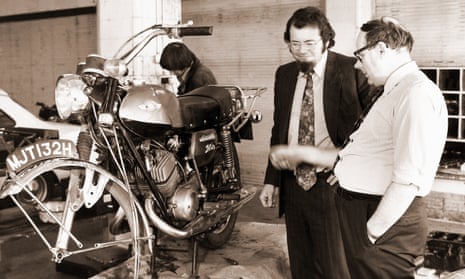John Haynes, who has died aged 80, created a publishing empire out of the enormous success of the car workshop manuals that bore his name. In all, 200m have been sold since 1966, covering the maintenance and repair of more than 1,000 different models.
His formula was simple: dismantle and rebuild a car, illustrate with clear black and white pictures and diagrams, then describe the process in detail, in a language that the lay person can understand. With the familiar yellow and red logo, impressive cut-away drawings, fault diagnosis and step-by-step approach to every possible task – be it changing a bulb or dismantling and rebuilding a complete engine – the Haynes manuals captured the DIY ethos of the 1960s, 70s and 80s: a more self-reliant time, when maintaining the family saloon was still a bastion of male pride and the vehicles most people drove were simple, logical and analogue.
Today, when few modern cars invite the attentions of the home mechanic and most people would struggle to find the dipstick, sales of Haynes manuals have been in decline. But it is an indication of how embedded the brand remains in the national psyche that it has been able to parody itself with manuals on the workings of The Man, The Woman, nuclear submarines and even a practical guide to sex. You can still buy a “real” Haynes manual, though, and since the founder’s retirement in 2010 his successors in the family-run business have fought back with digital technology that brings the concept up to date, using online downloadable workshop manuals.
Haynes was born in Ceylon (now Sri Lanka) to Violette (nee d’Henezel), a nurse, and Harold, a tea plantation manager. In 1950 the family returned to the UK, where, with his brother David, John attended Sutton Valence school near Maidstone in Kent. There John persuaded his headmaster to allow him to miss his rugby lessons so that he could rebuild his £15 Austin 7 saloon into one of the lightweight 750 “specials” that were many a young man’s fancy in impecunious times.
Not only did the 17-year-old sell the finished car at a profit; he decided he would write a booklet about the project. Drawing all the illustrations himself, he ran off 250 copies on a stencil duplicator; Building a 750 Special sold out in 10 days at five shillings a copy.
In the late 50s Haynes did his national service in the RAF, and later joined the air force for a further period, receiving a good grounding in business and logistical skills and finding time to race his Elva Courier car. He also got married: his wedding present in 1963 to Annette (nee Coleman-Brown) was a secondhand IBM proportional-spacing typewriter, which she used to produce the early Haynes manuals.

The first of these was a 1966 guide to the Austin-Healey Sprite, a tiny, cheeky sports car better known as the “frogeye” because of its amphibian-eye headlights. A friend, David Hyland, had bought a tired example that John was helping him to rebuild. Haynes soon realised that the official factory manual was of little use, and decided he could do a better job. Before long he had bought a camera to take step-by-step pictures of the dismantling and rebuilding of the car, the kitchen of his flat serving as a studio. In three months the first 3,000 print run of the Sprite Owners Workshop Manual had sold out, and Haynes was on his way.
He soon got the feel for which cars would make the best subjects: usually inexpensive, high-volume models that were popular among those who either could not afford garage labour rates or wanted the satisfaction of looking after the car themselves. The popularity of a particular title gave an interesting insight. He noticed, for instance, that sales of the 60s Vauxhall Viva HA manual were unusually high, a sure sign that the car had reliability issues. By a similar token, sales of manuals for certain Toyota and Mazda models were very low, indicating that the reputation for Japanese durability was no myth.
Sports cars were always money-spinners: the Haynes manual for the MGB, written in 1967, has never gone out of print; and at one stage, on the American market, Haynes was selling two Porsche 911 manuals for every actual car sold, suggesting that the manual was an aspirational purchase for people who could not afford the car itself.
As well as the manuals, Haynes was a major publisher of car histories and motor sport titles covering almost every marque; many of these are still the definitive word on their subjects.
Haynes Publishing became a public limited company in 1979 and its owner was appointed OBE in 1995. His success allowed him to indulge his undiminished passion for cars, and in 1985 he opened the Haynes International Motor Museum at the company headquarters in Sparkford, Somerset; it is now an educational charitable trust that has more than 400 vintage and classic cars and attracts 125,000 visitors a year.
Haynes is survived by his wife, two sons, John and Chris, and his siblings, David and Mary. Another son, Marc, died in 2016.

Comments (…)
Sign in or create your Guardian account to join the discussion